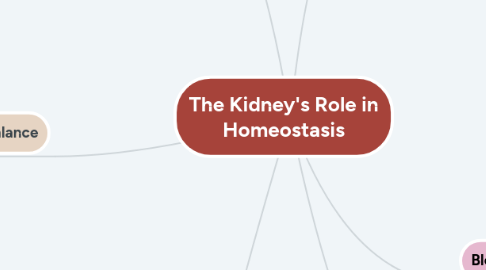
1. Acid-Base Balance
1.1. Normal pH Range: 7.35-7.45
1.1.1. Kidneys will excrete hydrogen ions and retain or excrete bicarbonate ions to maintain homeostasis
1.1.2. Bicarbonate ions (HCO3-) are a weak base and Carbonic acid (H2CO3) act as a weak base
1.2. CO2 + H2O ↔ H2CO3 ↔ H+ + HCO3-
1.2.1. In the rise of plasma pH (Alkalosis), the kidneys will inhibit bicarbonate reabsorption and hydrogen excretion
1.2.2. In the fall of plasma pH (Acidosis), the kidneys will reabsorb and secrete additional bicarbonate
2. Electrolyte Balance
2.1. Sodium
2.1.1. Sodium is reabsorbed through active transport in the proximal tubule
2.1.1.1. Na+
2.1.1.1.1. Increased level of sodium is corrected through ANP release
2.1.1.2. Na+
2.1.1.2.1. Decreased level of sodium is corrected through reabsorption in the convoluted tubule stimulated by Aldosterone (RAAS) and ADH
2.2. Potassium
2.2.1. Potassium is filtered by the glomerulus and majority of the potassium is reabsorbed in the proximal tube and the loop of Henle
2.2.1.1. K+
2.2.1.1.1. Aldosterone release to excrete potassium through urine
2.2.1.2. K+
2.2.1.2.1. Aldosterone is inhibited to decrease excretion of potassium
2.3. Calcium
2.3.1. 95% of calcium is reabsorbed in the renal tubules
2.3.1.1. Calcium
2.3.1.1.1. Parathyroid glands are stimulated via decreased calcium levels in blood and releases PTH
3. Fluid Volume Balance
3.1. Antidiuretic Hormone
3.1.1. ADH makes the body retain water
3.1.1.1. Too much ADH
3.1.1.1.1. SIADH
3.1.1.2. Too little ADH
3.1.1.2.1. Diabetes Insipidus
3.2. Atrial Natriuretic Peptide
3.2.1. ANP is found in the Atria of the heart and works in opposite of Aldosterone
3.2.2. Stimulated by increased volume in the vascular space and excretes sodium and water to decrease overall blood volume through inhibiting ADH; Renin; Aldosterone
3.3. Aldosterone
3.3.1. Steroid hormone found in the adrenal glands above the kidneys
3.3.2. Stimulated when blood volume is low, releasing aldosterone to increase retention of water and sodium, causing the blood volume to increase
4. Waste Excretion
4.1. Urine formation begins in the glomerular capillaries with dissolved substances passing into the proximal tubule as a result of force of blood pressure in the large afferent arteriole and the pressure in Bowman’s capsule
4.2. The renal tube is responsible for reabsorption and secretion
4.2.1. Reabsorption is the process of moving solutes from tubules and reabsorbing or returning them to the blood stream
4.2.2. Secretion is a process of transporting solutes in to renal tubules to be excreted in to urine
4.2.3. Reabsorption and secretion are both controlled by selective permeability of different areas of the renal tubule to water, sodium, and urea and the response of the distal collecting tubules in the kidney to hormones such as aldosterone, ADH, and PTH
4.3. Kidneys have the ability to dilute or concentrate urine depending on the individual’s physiological needs and to regulate electrolyte and toxin excretion
5. Blood Pressure Control
5.1. The kidneys work with the lungs, lover, an adrenal cortex through the renin-angiotensin-aldosterone system to regulate blood pressure
5.1.1. The liver synthesizes and secretes inactive precursor angiotensinogen and kidneys will synthesize and release renin when the blood pressure is low
5.1.2. Renin will be converts angiotensinogen in to angiotensin I, and ACE produced in the lung converts angiotensin I in to angiotensin II and angiotensin II will cause widespread vasoconstriction, increasing the blood pressure
5.1.3. Angiotensin II will stimulate the adrenal cortex to release the steroid hormone aldosterone, which causes the renal reabsorption of Na+, helping to maintain the blood pressure long-term

